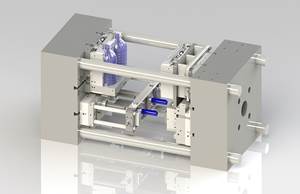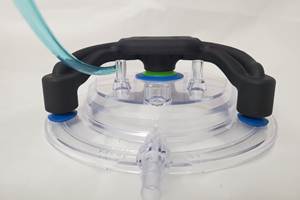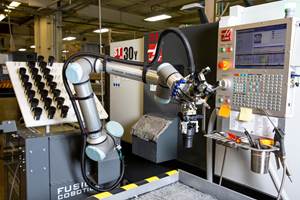Maguire Focusing on New Technologies to Help Processors Get More Efficient
NPE2024: Machine builder eyes gains in productivity and energy savings across product line to help processors boost efficiencies.
The drive toward sustainability and the circular economy could make plastics processors look at little more closely at their energy usage and expense. With the Ultra Dryer, Maguire Products is counting on it.
Maguire’s Ultra Dryer technology pulls a vacuum on the material to dry it up to six times faster than desiccant dryers, says Frank Kavanagh, vice president of sales and marketing. Drying by vacuum, Kavanagh says, dramatically reduces energy usage and significantly improves sustainability by reducing a processor’s Global Warming Potential (GWP). In a real-world scenario, on a process running 220 lbs/hr. (100 kg/hr.) an Ultra dryer provided savings of 54,120 kW a year.
At its booth, Maguire is displaying Ultra Dryers big and small: Model 150, 300, 600 and 1000, and is encouraging visitors to check out its online calculator ultra.maguire.com, where they can plug in their own variables (energy cost, material type, operation time, throughputs and more) to compute their savings.
For plastics processors in North America, energy is their third highest cost center, behind materials and manpower. Still, as Kavanagh notes, saving energy is generally more top of mind among processors in Europe. “For the North Americans, the hot button is improving productivity. But we want processors to realize that, because the Ultra dries so quickly, your startup time is much quicker. As a result, your changeovers from one material to the next are significantly shorter and, by using the calculator, people can see that for themselves.”
Of course, when you think of Maguire Products, odds are good that the first thing that comes to mind is gravimetric blending. There’s a good reason for that. Kavanagh notes the company has more than 68,000 gravimetric blenders operating at processing plants around the world and expects to hit 70,000 when it closes the books on 2024. The booth is packed with its line of customizable WSB blenders, as well as its full line of standard weigh-scale WSBs. Hoppers are now equipped with corner valves that make the unit more flexible by enabling it to dose anywhere from 400 g/sec. (less than 1 lb/sec.) up to 11,000 g/sec. (more than 24 lbs/sec.), notes Kavanagh.
“Processors need more flexibility in their blenders nowadays,” he says. “So now each hopper on the blender is independent, with its own independent dispensing device. We’re in a new world now. It’s not just a matter of having virgin and regrind as your main components. Processors need to feed and blend postconsumer reclaim (PCR). In some cases, they may have multiple PCRs going into the blend, and now we can customize these hoppers with up to six large valves and well as smaller valves for additives. The standard line of blenders didn’t give the user that amount of flexibility.”
Maguire is introducing a new blender called Fusion, so named because it mates the gravimetric blender with its MGF line of gravimeter feeders. With Fusion, the feeders are can be stacked under the blender and use a common controller or the blender can be remote from the feeders. Kavanagh explains why this comes in handy: “If you want to do a quick cleanout at the blender feed throat, you can have your primary materials running through your blender, but your additive components, your colors, can still be running in a feeder located below the blender right at the feed throat. Fusion combines the capability of the WSB gravimetric blenders with the versatility of the MGF feeders.”
Maguire is also displaying a new line of standard MGF feeders, offering what it calls “100% color inject.” Explains Kavanagh, “The product line is mainly for injection molding machines. In a molding machine, typically when the screw reverses, that’s when you get the signal to actually run the feeder. But what happens is when the screw begins moving forward, it exposes a gap in the backside of that screw that most people are not adding color to. This feeder generates two signals: a screw return and a forward signal. That way, we can actually add color when that screw is moving forward again, which is what we call 100% color inject.”
This week, Maguire is also showing its MGF Feeder Family for the first time in the U.S., showcasing a major expansion to its line of gravimetric feeders. This product line introduces five distinct families, providing processors with more flexibility for various applications and processes.
Says Kavanagh, “The MGF Feeder Family represents the next evolution in gravimetric dosing solutions, providing processors with a comprehensive range of options to optimize their material handling processes. The MGF+ line enables processors with differing needs to take advantage of multistation dosing of additives and masterbatches, giving users more choices on how best to dose, mix, and control materials at the process throat, and providing useful materials usage information.
Kavanagh adds, “Across our product line, our approach from the sustainability standpoint is a focus on energy savings and productivity gains as well providing as much flexibility to the processor as possible.”
Related Content
At NPE, Cypet to Show Latest Achievements in Large PET Containers
Maker of one-stage ISBM machines will show off new sizes and styles of handled and stackable PET containers, including novel interlocking products.
Read MoreBeyond Prototypes: 8 Ways the Plastics Industry Is Using 3D Printing
Plastics processors are finding applications for 3D printing around the plant and across the supply chain. Here are 8 examples to look for at NPE2024.
Read MoreFour Industry 4.0 Tech Adoption Insights from Indiana Plastics Manufacturers
As more plastics manufacturers step into the Fourth Industrial Revolution, insights have emerged about how best to approach the digital transformation journey.
Read MoreImpacts of Auto’s Switch to Sustainability
Of all the trends you can see at NPE2024, this one is BIG. Not only is the auto industry transitioning to electrification but there are concerted efforts to modify the materials used, especially polymers, for interior applications.
Read MoreRead Next
For PLASTICS' CEO Seaholm, NPE to Shine Light on Sustainability Successes
With advocacy, communication and sustainability as three main pillars, Seaholm leads a trade association to NPE that ‘is more active today than we have ever been.’
Read MoreBeyond Prototypes: 8 Ways the Plastics Industry Is Using 3D Printing
Plastics processors are finding applications for 3D printing around the plant and across the supply chain. Here are 8 examples to look for at NPE2024.
Read More




















